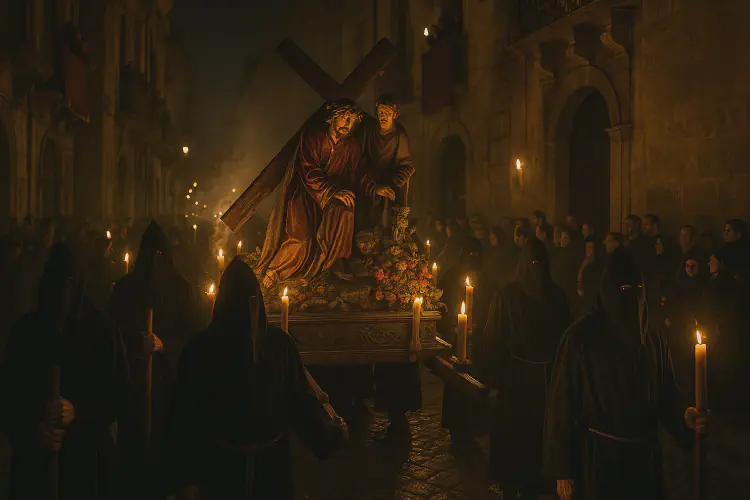Easter processions in Sicily
Easter in Sicily, or *La Settimana Santa*, is not just a religious observance — it’s a powerful emotional and cultural experience. Across the island, towns come alive with solemn processions, ancient chants, and reenactments of the Passion of Christ that blend **Catholic devotion**, **Spanish tradition**, and **Sicilian theater**.
- Visit Sicily
- 3 min read

Easter Processions in Sicily — Faith, Tradition, and Emotion
✝️ Overview
Sicily’s Holy Week (Settimana Santa) is one of the most intense and visually striking celebrations in Italy. Rooted in centuries-old Spanish and medieval traditions, it combines religious devotion, music, and rituals that express the island’s deep spirituality. Each town celebrates differently, but the processions all share one thing — profound emotion and community unity.
🕯️ 1. The Mysteries of Trapani (I Misteri di Trapani)
The most famous Easter event in Sicily and one of the oldest in Europe.
- When: Good Friday, lasting for nearly 24 continuous hours.
- What happens: 18 wooden sculptures (misteri), representing the Passion and Death of Christ, are carried through the streets by confraternities.
- Atmosphere: solemn yet rhythmic — the heavy statues sway to the beat of the annacata, accompanied by brass bands and incense.
- Origin: 17th-century Spanish influence, reflecting Baroque piety and artistry.
Tip: arrive early in Trapani’s old town to see the preparation of the floats and the emotional departure from the Church of Purgatorio.
🕊️ 2. Enna — The Procession of the Confraternities
A hauntingly beautiful event in central Sicily.
- When: Good Friday.
- Participants: over 2,000 hooded brothers from 15 different religious confraternities.
- What makes it unique: the sound of drums and chanting echoes through Enna’s narrow medieval streets as the faithful carry statues of Christ and the Virgin Mary.
- The solemn silence and uniform steps create an almost mystical experience.
Highlight: the meeting of the statues of the Virgin Mary and Christ on Easter Sunday — symbolizing resurrection and hope.
🖤 3. Caltanissetta — The Black Christ Procession (Cristo Nero)
One of Sicily’s most dramatic and emotional Easter events.
- When: Holy Wednesday.
- Main symbol: a dark wooden crucifix, said to have miraculous powers, carried through candlelit streets.
- Locals follow barefoot in penance, accompanied by Gregorian chants and torches.
- The atmosphere is both sacred and deeply human.
Fun fact: the Cristo Nero was brought from Spain in the 15th century and is believed to protect the city from calamities.
🌅 4. Modica and Scicli — The Joyful Resurrection Parades
In southeastern Sicily, Easter Sunday turns from mourning to jubilation.
- Scicli’s “U Gioia” parade: features a statue of the risen Christ carried in a lively run through cheering crowds.
- Modica’s procession: combines solemnity with celebration, ending with bells and fireworks.
Highlight: the contrast between silence of Good Friday and the explosion of joy on Easter Sunday.
💐 5. Marsala and Other Coastal Towns
- Marsala’s Processione dei Misteri features detailed wooden groups similar to Trapani’s.
- Palermo and Catania also hold Holy Week events, blending Franciscan humility with urban pageantry.
🎶 Sights, Sounds, and Symbols
- Music: slow, mournful brass bands accompany most processions.
- Dress: participants wear hoods and robes of their confraternities, often in white, black, or purple.
- Scents: incense and candle wax fill the air.
- Devotion: many people walk barefoot or carry crosses in thanks or prayer.
🍞 Traditional Easter Foods
After the solemnity of Holy Week, Sicilian tables fill with celebratory dishes:
- Cuddura cu l’ova: braided bread with colored eggs.
- Cassata Siciliana: rich ricotta cake decorated with marzipan and candied fruit.
- Agnello Pasquale di Pasta Reale: marzipan lamb-shaped sweets.
🧭 Summary
Easter processions in Sicily are not mere performances — they are living expressions of faith, identity, and community. From the somber mystery of Trapani to the jubilant resurrection of Scicli, each town adds its own voice to a centuries-old symphony of devotion. Experiencing Holy Week in Sicily is to witness the island’s heart laid bare — sacred, emotional, and profoundly human.